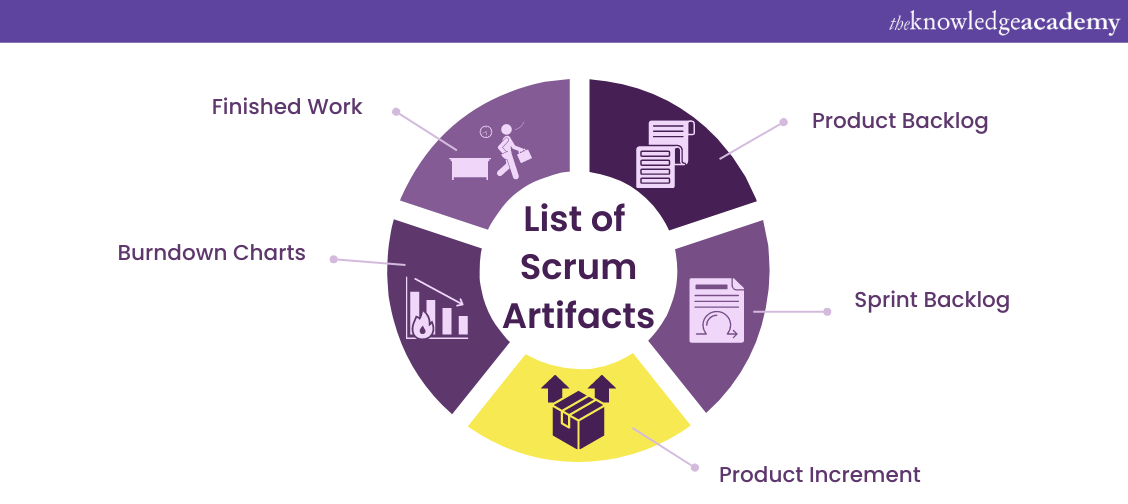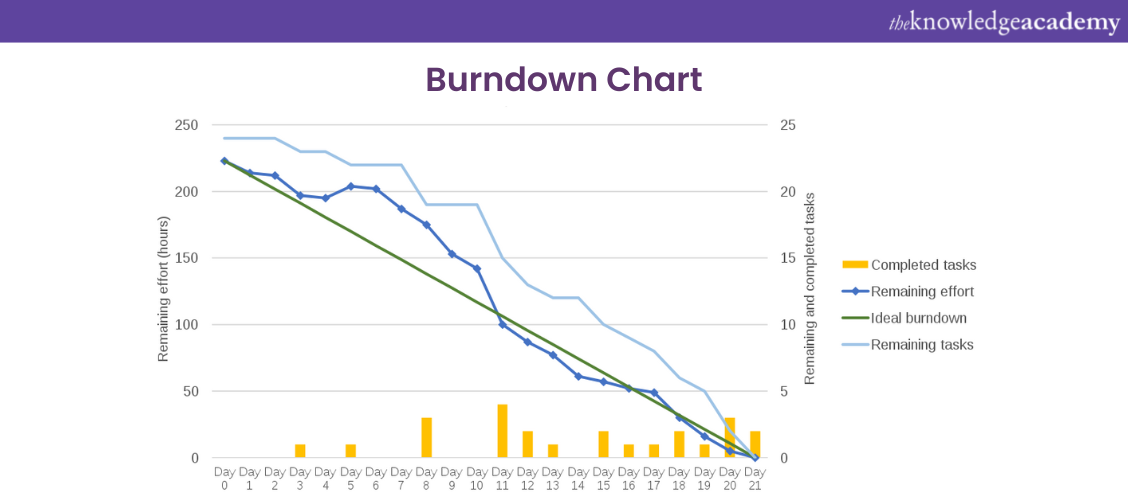We may not have the course you’re looking for. If you enquire or give us a call on 01344203999 and speak to our training experts, we may still be able to help with your training requirements.
Training Outcomes Within Your Budget!
We ensure quality, budget-alignment, and timely delivery by our expert instructors.

You are already aware of how the Agile methodology has positioned itself in the software development industry Among its one of the most popular Agile frameworks is the Scrum. One of its key features is the presence of Scrum Artifacts, which enable teams to work iteratively and incrementally while delivering value to the customers.
The 17th State of Agile Report by digital.ai states that at least 32% of Executives and business Leaders contribute toward Agile transformation. Additionally, Scrum’s popularity among stakeholders has given rise to Scrum Artifacts for better visibility and transparency. In this blog, we will closely examine those Artifacts and how they contribute to the success of a project.
Table of Contents
1) What are Scrum Artifacts?
2) What is Scrum?
3) Seven Scrum Artifacts: A comprehensive list
4) Advantages of Scrum Artifacts
5) Conclusion
What are Scrum Artifacts?
Scrum Artifacts in software development refers to vital information needed during the development of a project/product. Moreover, Scrum Artifacts includes information that a Scrum Team uses to develop a project and the actions needed to create it. They also include the actions performed during the project. Such Artifacts are significant because they give detailed insights into sprint performance on a particular project. They are useful for the following tasks:
a) Planning work and setting goals.
b) Creating tasks with respect to these goals.
c) Executing the Scrum Sprints
d) Organising tasks into sprints based on priority
e) Reviewing the results and comparing them to the goals set
f) Incorporating feedback into an iterative process

What is Scrum?
Scrum can be defined as a unique way to organise and manage a project using Agile project methodology. The project is divided into small parts, and the completion of each component is called a Sprint. After completion of every Sprint, the results are shown to the Product Owner to verify if the results are headed towards the right direction. A Sprint is usually completed in two to three weeks. Additionally, in larger projects, the Scrum of Scrums framework is employed to ensure coordination and communication among multiple Scrum teams, facilitating a cohesive approach to the overall project.
Understand and demonstrate Scrum values, practices, and applications in your organisation by doing a Scrum for Teams Course today!
Seven Scrum Artifacts: A comprehensive list
The Scrum realm includes certain Artifacts to ensure transparency, communication, and alignment within the team. These Artifacts further represent the work status, progress and goals. Let's delve into the seven essential Scrum Artifacts and explore their significance in the Agile landscape:

Product backlog
Product backlog includes a list of features or requirements that describe a product's desired functionality or outcomes. It is a central Artifact in Agile and Scrum methodology serving as a document that guides the development team’s work.
The Product Owner mostly maintains the product backlog, which evolves with the developed environment. It lists all the functions, features, requirements, improvement methods and other changes related to the product.
Typically organised by priority, the most critical items are usually at the top of the list in a product backlog. Each item on the backlog should be described in enough detail so that the development team can fully understand the project's requirements. It should also help them estimate the time and effort needed to complete it.
Along with this, the product backlog ensures that the development team always works on the priority items of the project. Externally, the main focus of product backlog is to provide visibility and transparency of the project's goals to the stakeholders.
Product vision
Product vision can be defined as the artifact that sets the end goal of a project. It allows the organisation to move in the correct direction throughout the project. Sometimes, the team might get distracted by different other requirements of the project and forget the main use of it. That’s when product vision works as a guide. Product Vision is never long; it is short and to the point. This way, the entire team remembers it by heart.
Sprint backlog
Sprint backlog is a to-do list created on the basis of product backlog. It specifically lists the tasks to be performed by the development team to achieve a finished product. Additionally, it defines plans to achieve product increments and sprint goals.
Upon the occurrence of a new assignment of the same project, the development team must add it to the sprint backlog. It should also include the estimated workload of every task that needs to be updated on the sprint backlog. This is because the Sprint Backlog is a transparent document that reflects the development team’s progress in a project.
During Scrum meetings, the development team reviews their progress on the sprint backlog and identifies any obstacles. This allows them to adjust their plans and ensure they are on track to meet their objectives.
At the end of the sprint, the development team present their completed work to the stakeholders. They review the sprint backlog and demonstrate how they have met the objectives they have committed to.
Learn in-depth about the key responsibilities of a Scrum Master; sign up with Scrum Master Certification now!
Product increment
The development team creates a product increment for each sprint involved in creating a project. While they do not necessarily need to be delivered, they must be in a deliverable state upon the decision of the Product Owner.
The development team must ensure that the Product Increment meets the definition of “Done”. “Done” essentially means that a product created by the development team meets a predefined set of criteria determined by the stakeholders and the Product Owner.
Development teams with issues with the definition of “Done” in a particular project can reach a consensus with the stakeholders and the Product Owner. This middle ground is achieved through extensive discussions on why the definition limits the work of the development team with all the stakeholders involved.
The biggest advantage of product increment is that it enables the development team to present their work progress to the stakeholders involved. During the sprint meetings, the development team also allows the stakeholders to interact with the product increments that are ready to be delivered.
Burndown charts
A burndown chart is an essential Scrum Artifact in the framework, that helps the development team in tracking and visualising progress during a sprint. It Is a graphical representation of the work remaining vs time during a sprint.

A Burndown Chart's vertical or Y axis typically represents the remaining amount of work, while the horizontal or X axis represents the time, usually in days or weeks. The chart starts at the total amount of work remaining; over time, the line on the chart would trend downward as the team completes more work.
The goal of a burndown chart is to help the development team stay on track and meet the sprint goal by providing a visual representation of progress. The team regularly updates the burndown chart to reflect the remaining work on the project. This chart clearly indicates if there are some pending tasks and whether the team can meet its sprint goal.
If the line on the burndown chart is trending above the ideal line, the team is falling behind and needs to increase its effort to meet the sprint goal. If the line on the burndown chart is trending below the ideal line, the team is ahead of schedule and ready to take on additional work if necessary.
Definition of done
Amidst every step in the framework, the most vital Scrum Artifact to the stakeholders is the finished work. In Scrum, finished work refers to a deliverable that meets the definition of “Done” to the stakeholders. The finished work must include all the necessary tasks, tests, and quality checks that ensure that the deliverable meets the stakeholders’ requirements and is of the highest possible quality.
The goal of finished work is not to complete every feature or requirement in a single sprint. Rather, it delivers a valuable and shippable product. This means that the team needs to focus on delivering the most important and high-priority backlog items. Moreover, they must ensure that they meet the definition of “Done” before moving on to the next sprint.
Advantages of Scrum Artifacts
Scrum Artifacts offer many advantages that push the completion of a project way more effectively. Let us have a deeper understanding of these advantages:
1) Constant collaboration: Constant collaboration helps a team to have discussions over doubts and solutions for a problem. It also helps the team discover more efficient ways to reach their goal.
2) Listing the duties: It is essential for everyone to hold accountability while completing a Sprint. Scrum Artifacts list the responsibilities of every member of a team, bringing more accountability to the table.
3) Clear vision: When everyone in the team works together, understanding their roles and responsibilities, the vision of the product becomes clearer.
4) Sets deadlines: Setting a deadline for the entire project can turn out to be a mess. Rather than that, having deadlines for all Sprints and small achievements keeps the team on track. This also helps the team keep track of the workload and how much area is covered.
5) Enhanced flexibility: Being flexible means being ready for alternative solutions and results. By increasing flexibility, the goals are met quickly with less resentment.
Conclusion
All the Scrum Artifacts and functions entirely align with the methodologies and practices of the organisation. They communicate the development team's step-by-step progress to the stakeholders, making them vital to the development process. The Framework of Scrum discussed above must be implemented completely to achieve an efficient and effective process.
Get to know the key concepts of Scrum in its entirety with Scrum Overview Training - sign up now!
Frequently Asked Questions

Yes, the Gantt chart marks a nice example of Scrum Artifact. The three Scrum Artifacts primarily include the sprint backlog, the product increment and the product backlog. All these Artifacts highly support a Scrum team’s progress.

The acronym for Scrum's three responsibilities, five events, and three Scrum artefacts is 3-5-3. Typically, people use it as a helpful tool to recall the fundamentals of Scrum.

The Knowledge Academy takes global learning to new heights, offering over 30,000 online courses across 490+ locations in 220 countries. This expansive reach ensures accessibility and convenience for learners worldwide.
Alongside our diverse Online Course Catalogue, encompassing 17 major categories, we go the extra mile by providing a plethora of free educational Online Resources like News updates, Blogs, videos, webinars, and interview questions. Tailoring learning experiences further, professionals can maximise value with customisable Course Bundles of TKA.

The Knowledge Academy’s Knowledge Pass, a prepaid voucher, adds another layer of flexibility, allowing course bookings over a 12-month period. Join us on a journey where education knows no bounds.

The Knowledge Academy offers various Scrum Certification Trainings, including the Scrum Master Certification, Scrum for Teams Training, and Scrum Developer Training. These courses cater to different skill levels, providing comprehensive insights into the Scrum Estimation Techniques.
Our Project Management Blogs cover a range of topics related to Scrum, offering valuable resources, best practices, and industry insights. Whether you are a beginner or looking to advance your Project Management skills, The Knowledge Academy's diverse courses and informative blogs have got you covered.
Upcoming Project Management Resources Batches & Dates
Date
 Scrum Master Certification
Scrum Master Certification
Thu 9th May 2024
Thu 23rd May 2024
Thu 30th May 2024
Thu 6th Jun 2024
Thu 13th Jun 2024
Thu 20th Jun 2024
Thu 27th Jun 2024
Thu 4th Jul 2024
Thu 18th Jul 2024
Thu 25th Jul 2024
Thu 1st Aug 2024
Thu 8th Aug 2024
Thu 15th Aug 2024
Thu 29th Aug 2024
Thu 5th Sep 2024
Thu 19th Sep 2024
Thu 26th Sep 2024
Thu 3rd Oct 2024
Thu 10th Oct 2024
Thu 17th Oct 2024
Thu 24th Oct 2024
Thu 31st Oct 2024
Thu 7th Nov 2024
Thu 21st Nov 2024
Thu 5th Dec 2024
Thu 19th Dec 2024







 Top Rated Course
Top Rated Course


 If you wish to make any changes to your course, please
If you wish to make any changes to your course, please


